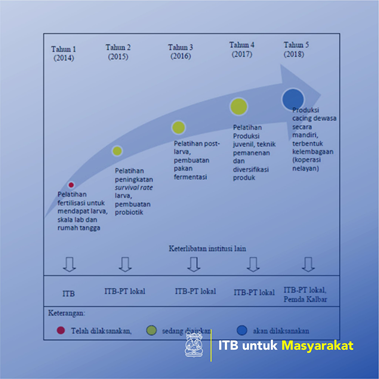

Ahmad Ridwan
The Nypa palm worm of Namalycastis, an indigenous species of West Kalimantan, has potential commercial value. The high level of biomass content of Namalycastis worms with average body weight of 30 grams is an advantage for raw material in aquaculture feed industry. Traditionally, the local community in Sei Kakap District of West Kalimantan Province make a livelihood by taking the worms from coastal mangrove forests and sell them as fishing bait. On the other hand, a decrease in worm population has been shown by the reducing number of worms taken daily. Therefore, worm cultivation should be an important thing to do in order to encounter the rapid exploitation in the nature. This activity was a continuity of ITB Program in Community Service in 2014 which was aimed for the assurance of Nypa palm worm population sustainability. In 2014, we have initiated the capacity building among traditional fishermen and preparing them for further competence needed for breeding and harvesting techniques. This year, we selected one the fishermen to be the group leader and set his house to be the pilot project for the juvenile to maturation. The house is located in Sei Itik Village, in Sei Kakap District. The group members were not only from surrounding areas but also from other districts. As local partner, the team member from University of Tanjungpura has facilitated the monitoring and evaluation of the whole program and set up an information center in Laboratory of Zoology, Department of Biology. We have succesfully not only maintained the larval production and growth in laboratory scale but also in fishermen community.
Pelaksanaan Kegiatan Kepedulian Sosial berupa pendidikan/penyuluhan/pendampingan
A decrease in Nypa palm worm population has been shown by the reducing number of worms taken daily. Therefore, worm cultivation should be an important thing to do in order to encounter the rapid exploitation in the nature.